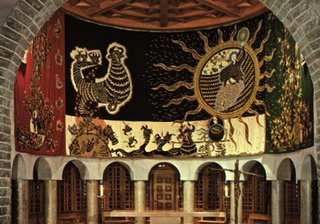
Art, Church and Life—“Breaking the Narrow Boundaries of the Infinite”
In my online class for pastors on presiding at the Eucharist a student referred the class to a church tapestry (his engagement with Rev. 12) and an related article[1] which contained this quote of Pope Pius XII: "The purpose of all art is to break the narrow boundaries of the finite, and open windows onto the infinite for the benefit of the human spirit, yearning in that direction." (Pope Pius XII in "Address to the First International Congress on Catholic Artist" Liturgical Arts 19 (1950), 3f.)
I replied to the student:
Even though the good Pope recanted this (or the more accurately the impersonal “Vatican” did so for him), I think in this statement he addresses your concern about right and left brain issues. If I am hearing you correctly you are saying, ‘Art, vesture, gesture, music, etc. used in the liturgy and in ‘charging’ Christian faith for the dialogue of the looking out and looking in function to ‘break the narrow boundaries of the finite, and open the windows onto the infinite for the benefit of the human spirit, yearning in that direction’?” Is that putting too many words in your mouth? [Is there any connection between this statement and his successor Pope John XXIII calling for the Second Vatican Council with the words "I want to throw open the windows of the Church so that we can see out and the people can see in."]
You do raise interesting and challenging questions related to the relationship of art and the Word. Certainly enlightenment Christianity and modernity's church has privileged the Word. That is part of what this course is about: attempting to discover in pastoral experience and practice the beauty of the Lord! It is about discovery that grace dawns not just through assertions in words and propositions, but in embodied, sensory expression--in enactment around public symbols. We who are ordained to preach the Word are also called to administer [lead the assembly in enacting] the Sacraments--the sacramental Word becoming flesh. If we don't do that and do it well, the gospel limps and our liturgical gatherings are blind and only mumble the good news that "human spirit[s]" yearn for.
The emergent church and its “emerging worship” approaches seem to yearn for worship and discipleship that “breaks the narrow boundaries of the infinite.” They seek art, symbol and semiotic play in “liturgical” life and in their dialogue with each other. Younger generations and those who are attuned to their spirit (a native postmodern orientation) seem to have developed a sense that to engage life we have to look through some lens at real things to “open windows onto the infinite.” If you go to YouTube.com it seems like everyone is looking through the lens of a digital camera. Much of what is posted is playful, even trivial, but the yearning is to see all of life and somehow get the pulse of the infinite incarnate in the day-to-day. Of course, the blatantly political is there in these days leading up to the election.
How does liturgy of the baptized become for us a graceful lens subverting the assumptions, values and commitments of the dominant, violent, consumerist culture so that we see alternative realities inherent in the gospel of God? Right brain reasoning can take us only so far. Left brain play and artful actions open the way for more adventurous possibilities. Is part of the reticence on the part of the current day churches to embrace the liturgy more fully a fear of such adventure and risk? Are the so called "emergent churches" toying with the ancient-future dimensions of liturgy precisely because of the “yearning” to “open windows onto the infinite”?
Daniel Benedict
[1] http://www.spiritualitytoday.org/spir2day/863814omeara.html

Comments